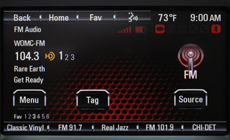 Road trip radio listening is a great way to get a snapshot of what radio is like around the country. I just completed a move to Portland, Oregon from Chicago. We had movers take the majority of our possessions, but my wife and I, along with two aging tabby cats, packed into a rented SUV to make the 2200 mile drive to our new home. Along the way we mostly listened to the radio.
Road trip radio listening is a great way to get a snapshot of what radio is like around the country. I just completed a move to Portland, Oregon from Chicago. We had movers take the majority of our possessions, but my wife and I, along with two aging tabby cats, packed into a rented SUV to make the 2200 mile drive to our new home. Along the way we mostly listened to the radio.
Quite to my surprise, we found FM stations that came in strong and had tolerable programming for nearly the whole trip. We tuned in classic rock, so-called “classic hits” and oldies stations that each played an entertaining mix of well-worn tracks that we know well. Certain artists, like Pink Floyd and the Rolling Stones, made frequent appearances, with Floyd’s “Time” being the my vote for the song I really don’t need to hear again for a while.
My typical radio listening does not include much classic rock or similar formats, so hearing these moldy oldies was fun and refreshing, rather than repetitive and boring. However, as we pulled into the driveway of our new place, I was finished with these stations.
I appreciated that many of the stations in smaller towns and markets tended towards more eclectic selections, hewing a little less strictly to format than stations in bigger, more tightly competitive markets.
Early on in the trip we captured WLLT-FM in northwestern Illinois. Calling itself “the sound of Sauk Valley,” at about 6 PM in the evening the station was obviously automated. It seemed as though the station has no ad inventory to speak of, with the only breaks being IDs, a pre-recorded weather forecast and a phoned in promo from the head of the local chamber of commerce. The idiosyncratic music mix included Toto and Marvin Gaye.
Our rental vehicle, a GMC Acadia, had an HD Radio, so it was also interesting to experience that service across the west. In general, HD Radio is fairly useless while on a road trip, unless you’re stuck in traffic. My experience was that the HD signals were only sufficiently strong for a short stretch of maybe 10 to 15 continuous miles in most cities. I could hear the Acadia’s radio shift back and forth between the analog and digital signals, though it was impressively smoother than I’ve experienced with other HD receivers.
When sitting in traffic or moving about town I checked out some HD2 stations and found them to be quite varied, my favorite being the all-funk channel in Portland. But when traveling on the highway it was difficult to hang onto most HD2 signals long enough for it to be an enjoyable experience.
What I particularly appreciated was stations with RDS service. RDS adds text data to a radio signal, which can be used to identify a station, display title and artist info, or even provide traffic news. As a radio geek, I liked seeing the call letters of the station I was receiving, frequently supplemented by the station’s tag line, the name
RDS encoders are relatively inexpensive, so I am sort of surprised that more stations don’t have them. In the major cities along our route, like Omaha and Boise, most stations used RDS, and at least half had HD. Smaller towns were much more hit and miss with RDS.
I was also pleasantly surprised at how many stations sounded like they had live local DJs, or local voice-tracked DJs, at the very least. I also heard quite a few very awkward automated segues. I also heard a couple of automated EAS alerts break into programming to announce severe weather warnings.
On one station in western Nebraska a live announcer came on during the next break to update the warning. It was the first I’d heard of that announcer–I believe the station was on automation–so I’m guessing that he broke in to provide severe weather coverage outside of his normal shift. That is the kind of service local radio should provide.
My little road trip across the Midwest and Northwest demonstrated that radio is alive and mostly well along our nation’s interstates. I just hope you like Pink Floyd.


